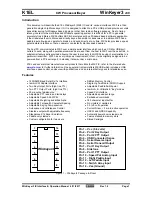
Peripheral source
NVIC line
EVSYS – Event System
8
SERCOM0 – Serial Communication Interface 0
9
SERCOM1 – Serial Communication Interface 1
10
SERCOM2 – Serial Communication Interface 2
11
SERCOM3 – Serial Communication Interface 3
12
SERCOM4 – Serial Communication Interface 4
13
SERCOM5 – Serial Communication Interface 5
14
TCC0 – Timer Counter for Control 0
15
TC0 – Timer Counter 0
16
TC1 – Timer Counter 1
17
TC2 – Timer Counter 2
18
TC3 – Timer Counter 3
19
ADC – Analog-to-Digital Converter
20
AC – Analog Comparator
21
PTC – Peripheral Touch Controller
22
SLCD - Segmented LCD Controller
23
AES - Advanced Encryption Standard module
24
TRNG - True Random Number Generator
25
11.3. Micro Trace Buffer
11.3.1. Features
•
Program flow tracing for the Cortex-M0+ processor
•
MTB SRAM can be used for both trace and general purpose storage by the processor
•
The position and size of the trace buffer in SRAM is configurable by software
•
CoreSight compliant
11.3.2. Overview
When enabled, the MTB records the changes in program flow that are reported by the Cortex-M0+
processor over the execution trace interface. This interface is shared between the Cortex-M0+ processor
and the CoreSight MTB-M0+. The information is stored by the MTB in the SRAM as trace packets. An off-
chip debugger can extract the trace information using the Debug Access Port to read the trace
information from the SRAM. The debugger can then reconstruct the program flow from this information.
The MTB stores trace information into the SRAM and gives the processor access to the SRAM
simultaneously. The MTB ensures that trace write accesses have priority over processor accesses.
An execution trace packet consists of a pair of 32-bit words that the MTB generates when it detects a
non-sequential change of the program pounter (PC) value. A non-sequential PC change can occur during
Atmel SAM L22G / L22J / L22N [DATASHEET]
Atmel-42402E-SAM L22G / L22J / L22N_Datasheet_Complete-07/2016
45















































